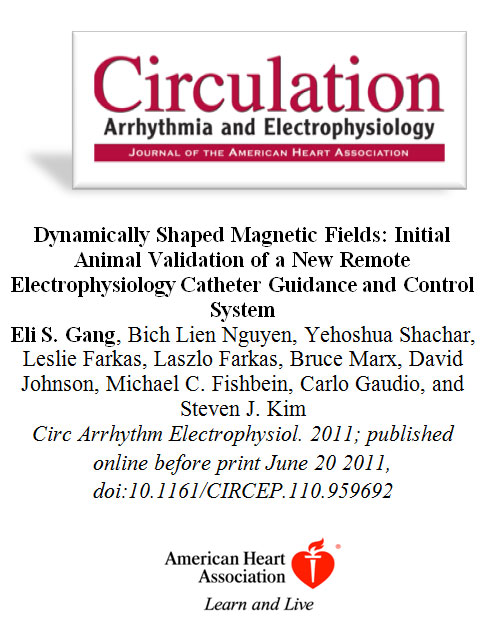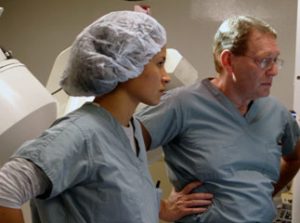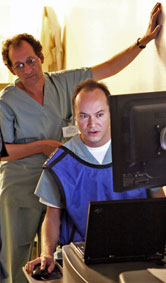
Journal of the American Heart Association Article
The Journal of the American Heart Association, a peer-reviewed and open access scientific journal for the American Heart Association, published a paper entitled “Dynamically Shaped Magnetic Fields: Initial Animal Validation of a New Remote Electrophysiology Catheter Guidance and Control System” in their June 2011 edition. has been published online in advance of its appearance in the print version of the medical journal
The paper summarizes the results of the initial feasibility study of remote electroanatomic mapping, navigation, and ablation in animals, performed by the Catheter Guidance Control and Imaging (CGCI) system. Catheter ablations were guided both manually and automatically by the CGCI system to approximately 30 sites per animal in 10 porcine studies. Using the unique closed-loop automated mode, the studies demonstrated 96% reproducibility, defined as the ability to acquire the same stable point 5 consecutive times; repeatability with 91% successful target acquisition; accuracy defined as the maximum final distance from the fixed target point of 1.9 mm; and a time to reach the designated target points of approximately 11.6 seconds.

Dr. Eli Gang, M.D., lead author
“The animal studies summarized in this paper verified that the Magnetecs robotic CGCI system can deliver rapid, stable, reproducible, and highly accurate maneuvering of catheters within the beating heart. The novel CGCI remote navigation system provides near real-time manual as well as automated closed-loop catheter control that is both agile and reproducible. Transmural ablations were achieved in a majority of the lesions even though transmurality was not a goal of the study,” said Dr. Eli Gang, M.D., lead author of the article, Chief Medical Officer of Magnetecs and Clinical Professor of Medicine, Geffen School of Medicine at UCLA.

Dr. Nguyen and Dr. Gang participating in CGCI animal study
<center>
The paper’s other authors are Dr. Bich Lien Nguyen, M.D., Ph.D., Assistant Professor of Medicine at the Sapienza University of Rome; Yehoshua Shachar, CEO, Magnetecs Corporation; Leslie Farkas, former Vice President, Engineering at Magnetecs Corporation; Laszlo Farkas, Chief Scientist, Magnetecs Corporation; Bruce Marx, Vice President, Director of Real-Time and Control Software, Magnetecs Corporation; David Johnson, Vice President, Director of Software Engineering, Magnetecs Corporation; Dr. Michael C. Fishbein, M.D, Pathologist, Ronald Reagan UCLA Medical Center; Dr. Carlo Gaudio, M.D., Director, Heart and Great Vessels Department, Sapienza University of Rome; and Steven J. Kim, Senior Director, Advanced Applications, AF Division, St. Jude Medical, Inc.

Josh Shachar observing Steven Kim of St. Jude Medical processing heart mapping images
“The CGCI system is an intuitive platform, and the operator learning curve is short. In its present configuration, CGCI is a practical and flexible system and enhances the capabilities of the electrophysiology catheterization laboratory,” said Dr. Bich Lien Nguyen, M.D., Ph.D., co-author of the paper and Assistant Professor of Medicine at the Sapienza University of Rome. “CGCI has been extremely effective during my preliminary experience in animals and patients, and I look forward to the chance to utilize CGCI in clinical ablation procedures. My expectations are that CGCI would make it possible for physicians to better manage clinical workflows and achieve procedural successes.”

